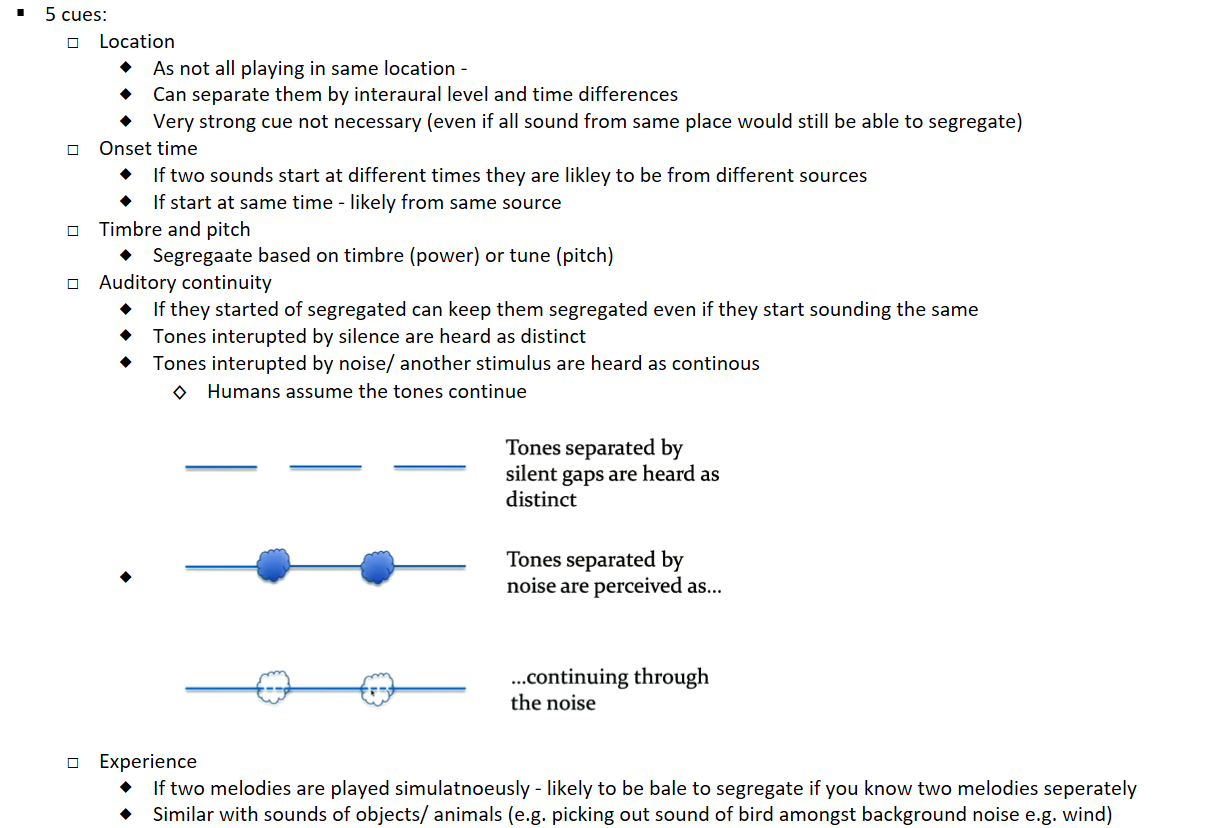Lecture 6 - Auditory Perception
1/30
There's no tags or description
Looks like no tags are added yet.
Name | Mastery | Learn | Test | Matching | Spaced |
|---|
No study sessions yet.
31 Terms
If a tree falls in the forest and no one is there to hear it, is there a sound?
Yes and no is true
Seemlingly obvious on both sides
Yes -> sound is phsyical, and can be measured
No -> if no ones there, it won't be sound (no one to percieve the pressure waves in air as sound)
suggests that sound is an ambigous term
what does is mean for sound to be an ambigous term - describe physical properties of sound
phsyical vs perceptual sound
Physical properities don't always determine auditory properities (similar to colour - different colours may be percieved different)
Sound is pressure changes - change in high/low pressure over time - sound is pressure waves that move away from a source
Sound moves through air at 340m/s and water at 1500m/s
Only pressure waves moving (not air molecule moving)
Each air molecule simply moves back and forth creating reigons of high and low pressure
Like a slinky spring (rings move back and forth but pressure moves in one direction)
Longitudinal pressure waves
Sine wave - doesn't have to be
What is a pure tone
Only one frequency
Sinusoidal
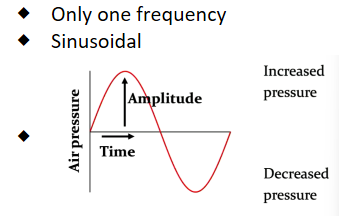
What is frequency (in relation to sound)?
gaps between pressure changes
The higher the frequency the higher the sound (usually)
Humans can hear tones from 20 Hz to 2000 hz
What is amplitude (in relation to sound)? + give some examples of amplitude of different objects
the higher the amplitude that louder a sound seems
Amplitude measured in decibels (db)
dB = 20 x log(p/p02)
P is the maximum amplitude
P0 is refernce pressure usually set to 20 micropascals (measure of pressure)
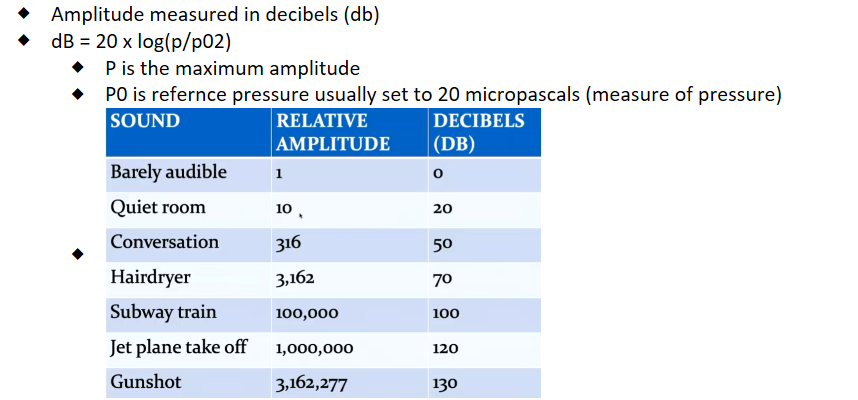
What are complex tones
tones with mutliple frequencies involved
if all the frequencies are multiples of the smallest → harmonics
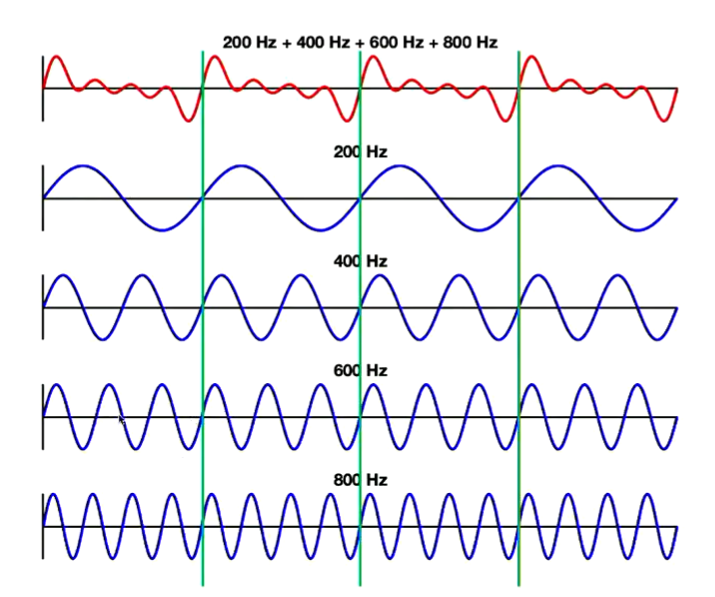
Describe harmonics + describe this tone
smallest frequency tone is the first harmonic
multiple of 2 is second harmonic
times 3 is third harmonic etc
e.g.
200 hz is first harmonic (fundamental frequency)
400 hz is second harmonic
600 hz is third harmonic
800 hz is fourth harmonic
What are the different physical aspects of a sounds?
frequency (high vs low tone)
amplitude (lodness)
What are the different perceptual aspects of a sound
frequency
pitch
timbre
Describe frequency and amplitude relationship (what it is determined by and how it is measured/described)
frequency usually but not always determined by physical aspects of sound
The greater the amplitude the louder a sound seems
The actual loudness also depends on frequency
Perceptual loudness is measures in phons (units of loudness for pure tones)
The frequencies we are more sensitive to, sound lourder for a given/constant amplitude
The frequencies we are less sensitive to will not sound at loud (unless amplitude is increased)
Eventually we reach a frequency we cannot hear at all and changing amplitude will not make us hear it
Describe pitch (what it is determined by and how it is measured/described)
pitch is basically the perceptual translation of frequency - how high/low it is - subjective however
Pure tone - determined by frequency (tuning fork - frequency of sine curve is pitch)
For complex tones - usually determined by fundamental frequency (first harmonic)
“Usually” because pitch is psychological quanitity not physical
Can say: tone has a frequency of 200hz
Cannot says: a tone has a pitch of 200hz (perceptual)
Pitch usually described in letters - musical scales notes (A,B,C) : piano (multiple repeating letters)
All notes corresponding to same letter are multiples of the same frequency (harmonics) -> sound similar (same chroma)
C1 - C7 has increasing pitch
Neighbouring letters of same letter are seperated by an ocatve
Have two components - chroma (all of same letter has same chroma) and tone height (increases from left to right on piano)
Chroma is cyclic (A-FA)
Tone increases in keyboard in continous manner
what are components of pitch
chroma (all of same letter has same chroma) and tone height (increases from left to right on piano)
What is fundamental frequency determined by
(this is the first harmonic)
will be the smallest frequency present in the harmonic complex tone
all other frequencies are multiples of it :
determined by point in which all components repeat

What happens when there is a missing fundamental to sound?
Complex tone repeats at fundamental frequency
Will continue to repeat at fundamental frequency - even when it is missing
This is because all components are multiples of it
Consequently, humans percieve (hear) fundamental frequency even when it is absent
Fiscal quantities don't always translate to perceptual
Missing fundamental determines the pitch of the complex tone
e.g. can hear 100hz of male voice in telephone even though telephones do not produce sound below 300hz
Frequency spectrum - shows the amplitude of
each frequency component of the complex tone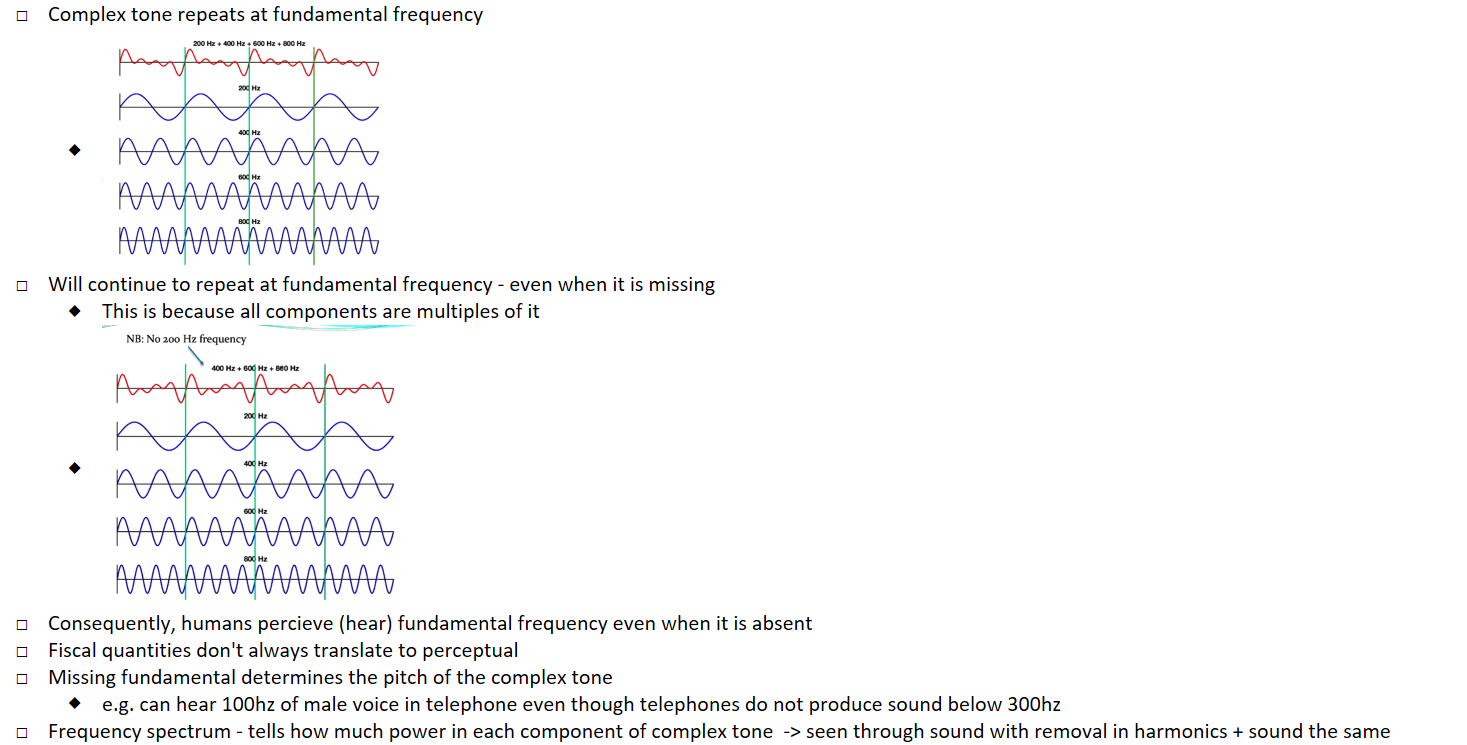
Describe timbre
amount of power in higher order harmonics (harmonics determine timbre)
even if same fundamental frequency is used - different instruments sound different due to varying timbre
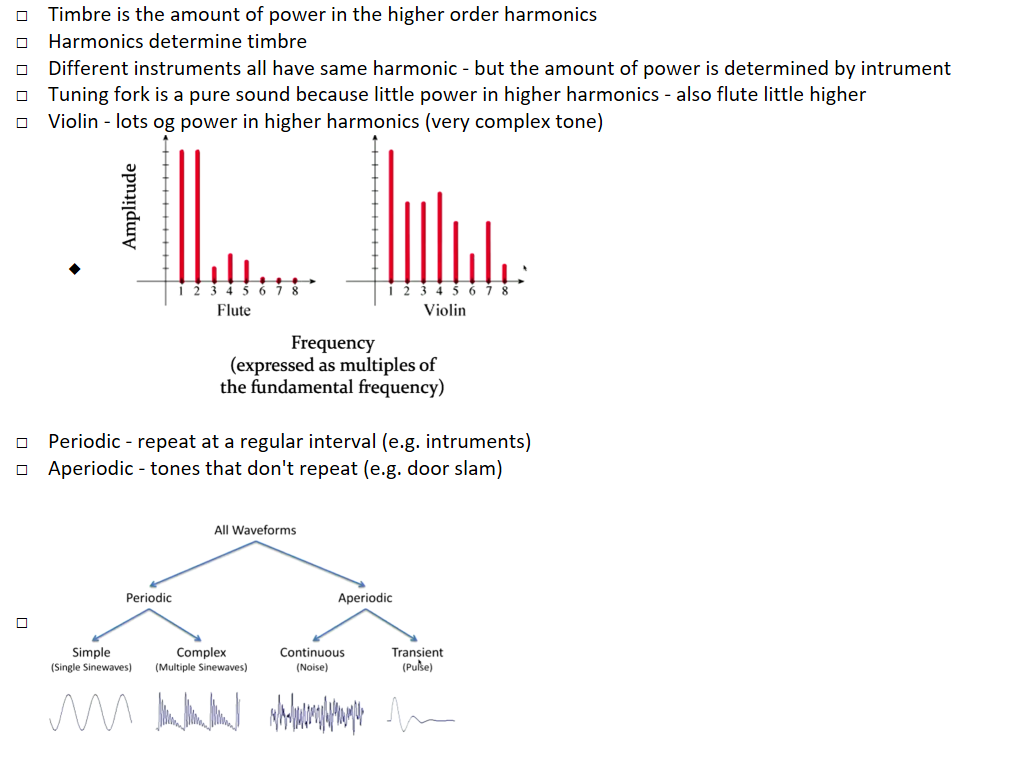
Contrast periodic vs aperiodic sound (timbre)
Periodic - repeat at a regular interval (e.g. intruments)
Aperiodic - tones that don't repeat (e.g. door slam)

Describe how we can pinpoint where a sound comes from - auditory localisation
binaural cues (cues for both ears)
interaural time difference (one ear may hear something first)
interaural level difference (volume difference between ears)
Monoaural cues (one ear)
can understand elevation of sounds within cone of confusion as sound bounces of ear different depending on elevation - creating characteristic notch
Describe interaural time difference
Interaural time difference (time difference between ears)
Point A is closer to left ear than right ear
Thus, sound generated at point A will be heard at left ear before right ear
Describe interaural level difference
For high frequency sounds there can be a larger interaural level difference
(for low frequency less - too complex why)
For high frequency sounds there is a sound shadow
Ear expsoed to sound gets a much higher amplitude than ear not exposed (as head shadows that ear)
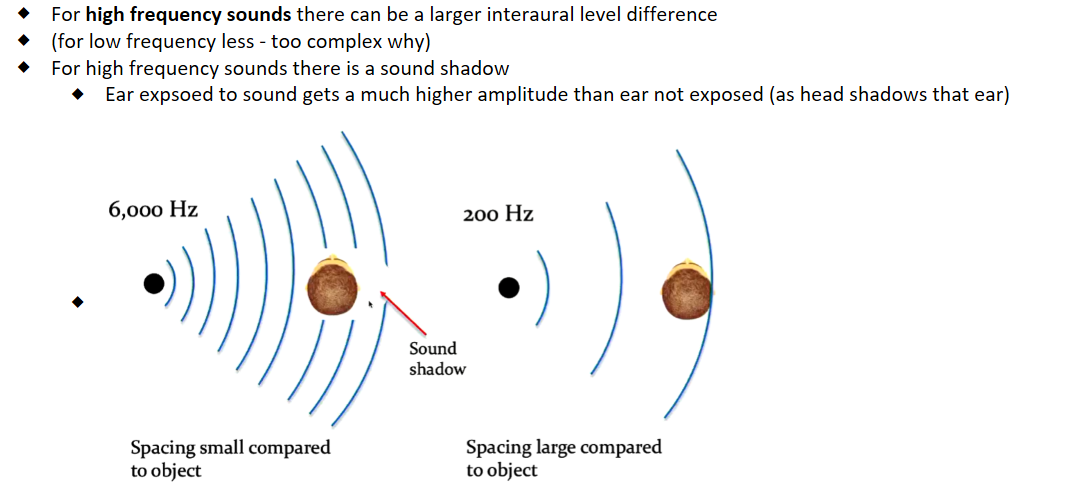
Describe monoaural cues
What is the notch created when hearing something higher up
no notch
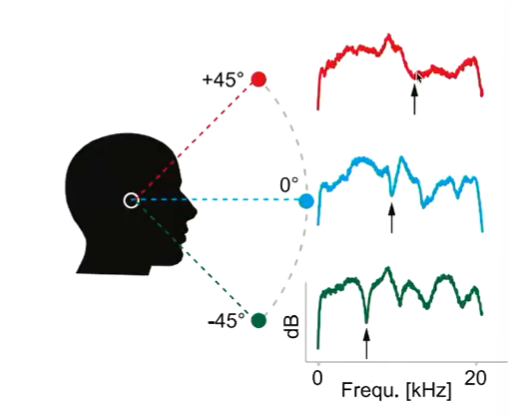
What is the notch created when hearing something midline
less pronounced and at higher frequency than from below

What is the notch created when hearing something below
very pronounced notch

Describe what happens when hearing inside rooms
Hear from both direct (from mouth) and indirect (bouncing off walls and objects)
Why don’t we hear echos?
If you hear the same sound twice with a temporal separation of 5-20ms you will not reigster second / indirect sound
You will not hear echo
Supressing physical stimulus (another example of what you percieve/ hear is not equal to phsyical)
Better function + hearing
If temporal seperation is more than a 1/10th of second - will hear an echo (thus is a cave - long distance - long time to bounce off and come back)

What is reverberation time
Time it takes for sound to decrease by 60 dB
Everytime sound bounces a wall it decreases in amplitude
Concert hall - 2 s (sound bouncing lots of times - getting lots of indirect sound)
Opera hall - 0.5 s (to make voices more distinguishable)
What is intimacy time
Temporal difference between when direct sound arrives and first indirect sound arrives
Concert halls - 20 ms (good acosutics)
What is base ratio (respect to indoor hearing)
Measured by indirect sound
Ratio of low frequency to middle frequency for indirect sound
Ideally want a high base ratio
What is spaciousness factor (indoor hearing)
Ratio of indirect sound to total sound
Greater the proportion of indirect - the greater the spaciousnes factor
Ideally want it to be high
What are the purpose of pillows - archietectural hearing indoors
Want concert hall to sound the same regardless of how many people there (filled/not filled)
People absorb sound
Pillows at back of hall to absorb same amount of sound as people
Thus acoustics of hall will be same whether full or empty
What are the factors that affect indoor hearing and architectural acoustics
Reverberation time
Time it takes for sound to decrease by 60 dB
Everytime sound bounces a wall it decreases in amplitude
Concert hall - 2 s (sound bouncing lots of times - getting lots of indirect sound)
Opera hall - 0.5 s (to make voices more distinguishable)
Intimacy time
Temporal difference between when direct sound arrives and first indirect sound arrives
Concert halls - 20 ms (good acosutics)
Base ratio
Measured by indirect sound
Ratio of low frequency to middle frequency for indirect sound
Ideally want a high base ratio
Spaciousness factor
Ratio of indirect sound to total sound
Greater the proportion of indirect - the greater the spaciousnes factor
Ideally want it to be high
Pillows
Want concert hall to sound the same regardless of how many people there (filled/not filled)
People absorb sound
Pillows at back of hall to absorb same amount of sound as people
Thus acoustics of hall will be same whether full or empty
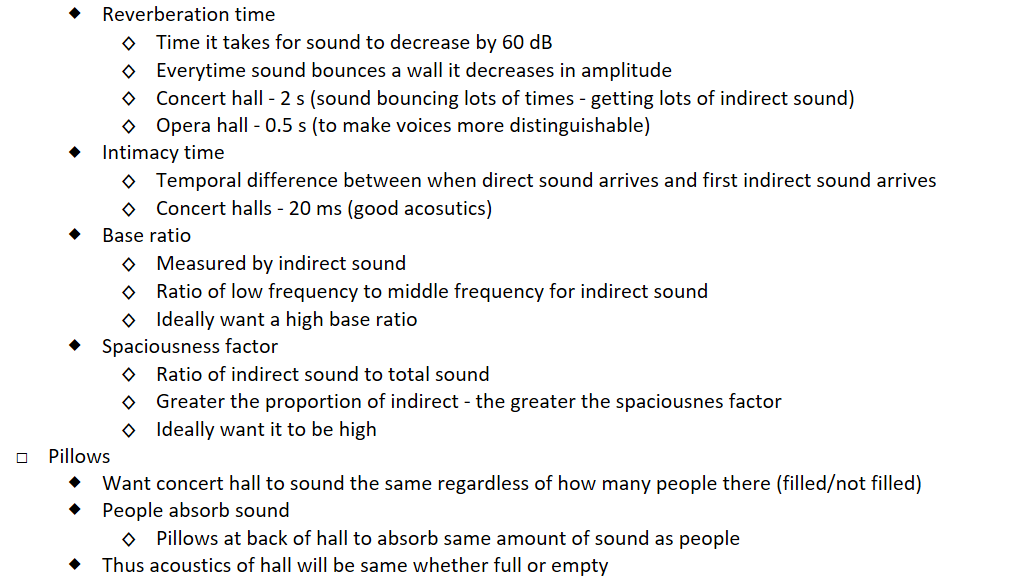
How can we distinguish / seperate between sound sources?
